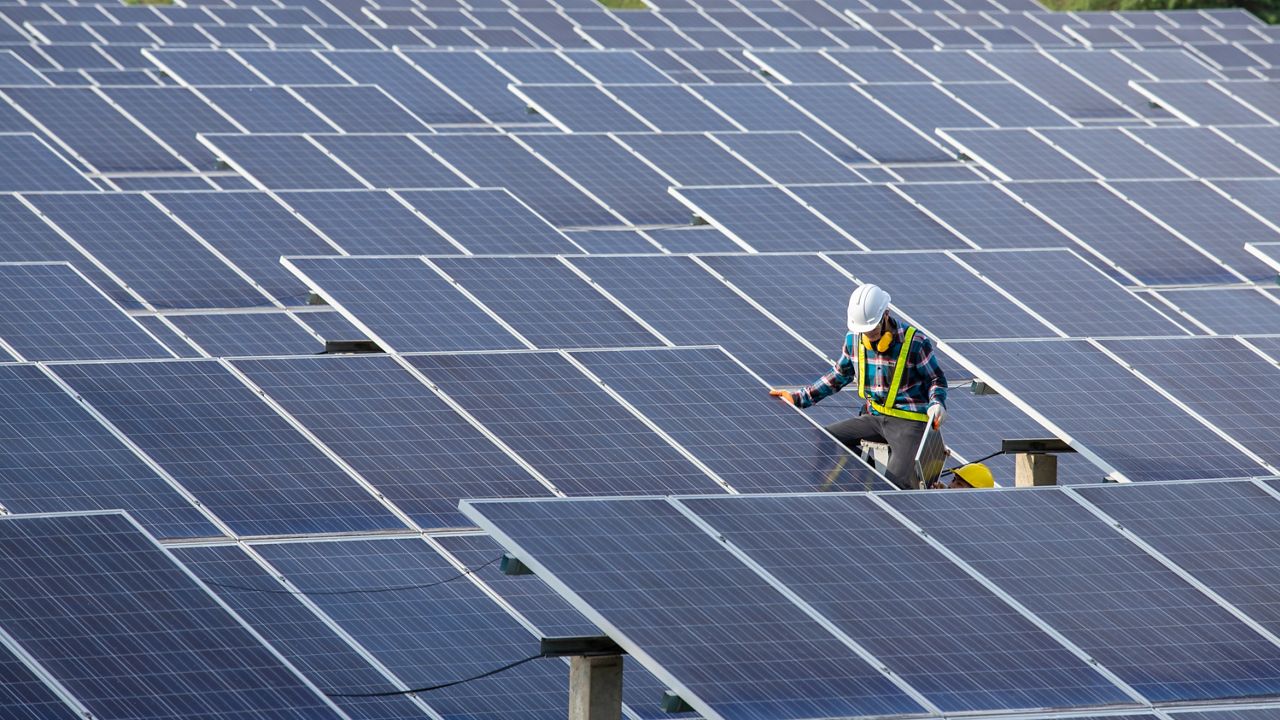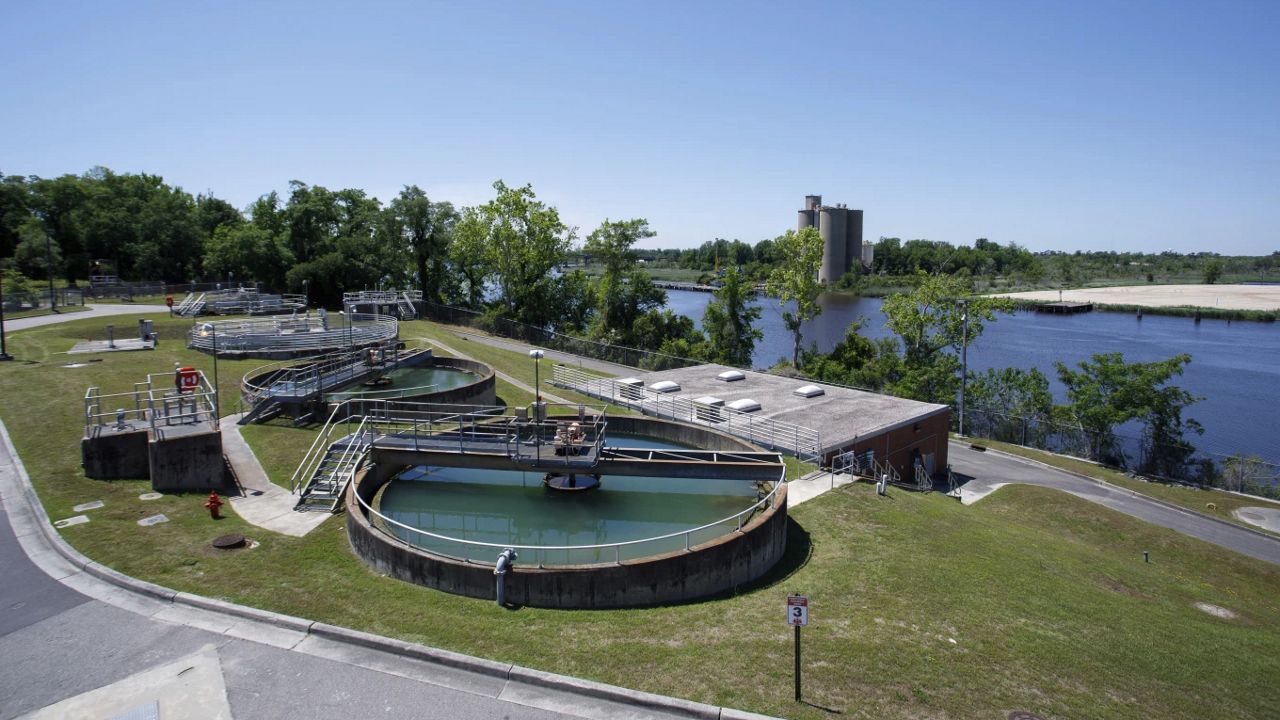North Carolina lawmakers in October passed House Bill 951, requiring the state to cut carbon emissions from power companies 70% by 2030. The law states North Carolina power companies have to be carbon neutral to 2005 levels by 2050.
Part of that law required regulators to come up with a plan by the end of 2022 to cut emissions from power companies and hit the targets. The North Carolina Utilities Commission released that plan on Dec. 30, mostly leaving it up to Duke Energy, the state’s main power company, to figure out how to reach those targets.
The carbon plan requires Duke Energy to retire its remaining coal-fired power plants by 2035, build new solar farms and battery storage. But environmental advocates had hoped the commission would go further to require the company to add more clean energy to North Carolina’s power grid.
Gov. Roy Cooper and the GOP leaders in the General Assembly gathered at the governor’s mansion in October 2021 for a ceremonial signing of House Bill 951, called Energy Solutions for North Carolina.
The bipartisan bill was an important part of the state’s efforts on climate change. It requires serious reductions in carbon emissions from one of the top polluting industries: energy. The goal is to have the state’s power generation “carbon neutral” to 2005 levels by 2050, meaning the state’s energy producers get back to the level it was 17 years ago.
“Making transformative change is often controversial and never easy, especially when there are different points of view on big, complex issues. But coming to the table to find common ground is how government should work,” Cooper said when he signed the bill into law.
Part of that bill required the Utilities Commission, which regulates power companies, to come up with a plan by the end of 2022 to hit the carbon reduction targets.
Regulators held hearings, took public comments and received plan proposals from Duke Energy and environmental advocates.
In the end, the Utilities Commission ordered Duke Energy to hit some short-term targets, but left open the bigger questions about what power generation will look like in North Carolina in the future. The plans included a mix of solar, wind, natural gas and nuclear, but regulators did not give Duke Energy a directive on what that mix of energy sources should be.
“Rather than approve a single, preferred portfolio of generation assets, the Commission, as provided for in the law, adopts reasonable steps, including the approval of a number of near-term actions, toward meeting the carbon dioxide emissions reduction mandates,” the commission said in a statement released Dec. 30.
The new carbon plan does not lay out the 30-year clean energy plan that some had hoped to see from the commission. But it does set about a dozen directives and actions for Duke Energy to take in the coming years. The clean energy law requires regulators to go back every two years to revise the plan.
Here are some of the actions included in the plan for Duke Energy:
- Retire its remaining coal-fired power plants, about 9,000 megawatts, by 2035
- Direct Duke to study offshore wind power. The company already won a lease for an off-shore wind farm off Wilmington
- Add on-shore wind as a possibility as it considers models for future energy production
- Extend the license for existing nuclear power plants and begin planning for new nuclear power plants
- Plan for new natural-gas power plants
- Buy 2,350 MW of new solar capacity to be in service by 2028
- Upgrade transmission facilities to handle new solar
- Give the company permission to buy 1,000 MW of battery storage and another 600 MW of storage paired with solar
Environmental groups are not happy about the inclusion of new gas-powered plants or small nuclear reactors in the plan.
“Expert analysis showed that North Carolina does not need to rely on speculative new technologies or the addition of any new fossil infrastructure, including any new gas,” the Southern Environmental Law Center said in a statement.
“To the contrary, the Inflation Reduction Act recently signed into law by President Biden will significantly reduce the cost of zero-emission resources like wind and solar, resulting in dramatic expansion of those resources and reduction in power-sector emissions,” the organization said.
The plan came out as the Utilities Commission continues to look into Duke Energy’s rolling blackouts during the frigid temperatures on Christmas Eve and the ongoing investigation into the substation attack that left Duke customers in Moore County without power for days.
“The emergency outage events this month particularly underscore the need for an orderly transition away from fossil fuels to low and zero carbon dioxide emitting generating resources while maintaining or improving the reliability of the electric grid,” the commission said.
North Carolina’s clean energy mix is still an open question. Duke Energy submitted four proposals to the commission with different options for how the company thinks it can hit “carbon neutral” by 2050. Those options included solar, gas, nuclear, wind and hydroelectric.
Part of the mix could include “advanced small modular reactors,” smaller nuclear power plants that are still in the testing and development phase. That technology is still years away from being used commercially.
“We believe this is a constructive outcome that advances our clean energy transition, supporting a diverse, ‘all of the above’ approach that is essential for long-term resource planning,” Duke Energy said in a statement.
“We’ve already made incredible progress, retiring two-thirds of our aging coal plants in North Carolina and South Carolina and reducing emissions by more than 40% since 2005 – we will continue this ongoing work of lowering carbon emissions to reduce risk for our customers while balancing affordability and reliability.”
The affordability aspect is an important part of the equation, and it’s part of the Utilities Commission’s mandate to keep power bills from getting too high.
“The communities we serve are already seeing the benefits of this transition. Customers in both states deserve a clean energy plan that supports communities and keeps rates as low as possible, while ensuring the continued economic competitiveness that the Carolinas depend on,” Duke Energy said.
The company is required to file a revised plan with the Utilities Commission by Sept. 1. Duke Energy also has a new plan due to the South Carolina Public Service Commission in August.
Whether Duke Energy can hit the clean energy targets, and how will it get there, are still open questions.
A coalition of environmental groups, including the Sierra Club, the Natural Resources Defense Council and the Southern Alliance for Clean Energy, are not convinced they will.
“The plan released today by the commission risks missing the bipartisan legislative mandate of 70% emissions reductions from the power sector by 2030, and allows Duke to plan to rely on new polluting, costly gas instead of putting North Carolina on a ‘no regrets’ path focused on clean energy,” the organizations said in a joint statement from the Southern Environmental Law Center.
The groups said the 70% goal by 2030 could be achieved with a combination of more energy efficiency and more renewable power sources like wind and solar.
Three of the four proposals submitted by Duke Energy did not hit the 2030 target, Southern Environmental Law Center said. The options regulators adopted for now “are based almost entirely on plans that miss that deadline,” the organization said.
“North Carolina can meet state carbon-reduction goals on time and in a cleaner and more affordable way than suggested by Duke Energy and endorsed by the Commission. Expert modeling shows a no-regrets pathway that would have better fostered the growth of our clean energy economy and created a healthier environment for North Carolinians,” said David Neal, with the Southern Environmental Law Center.
Many other states have gone further than North Carolina as they work to reduce greenhouse gas emissions.
States like Wisconsin, Virginia, Nevada, New Jersey, New Mexico, Colorado and California have either executive orders or legislation directing utilities to switch to all renewables or be completely carbon free in the coming decades. Those states all set deadlines between 2040 and 2050, according to the Clean Energy States Alliance.
Of the 23 states listed by the Alliance with clean-energy mandates, most are using a combination of renewables like wind and solar, and some are putting nuclear in the mix. Nuclear is carbon-free, but it’s not considered a renewable energy source.
Duke Energy has three nuclear power plants in North Carolina, and a third just south of Charlotte in South Carolina. Those are all included as part of the planning in the state’s efforts to get energy production carbon neutral.









